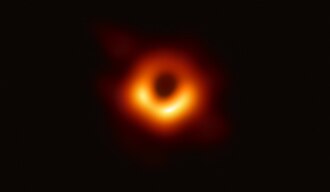Supermassive black hole


A supermassive black hole (SMBH or less often SBH) is a black hole with a mass that is between 105 and 1010 the mass of the Sun. Scientists are confident that almost all galaxies, including the Milky Way, have a supermassive black hole at each of their centers.
Formation[change | change source]
How supermassive black holes get started is not yet known. Astrophysicists agree that once a black hole is in place in the center of a galaxy, it can grow by attracting matter and by merging with other black holes. Formation of ordinary (star-sized) black holes from the deaths of the first stars has been extensively studied and supported by observations.
However, there appears to be a gap between stellar-mass black holes, and supermassive black holes.
Stellar-mass black holes, formed from collapsing stars, range up to perhaps 33 solar masses. The minimal supermassive black hole is in the range of a hundred thousand solar masses. Between these extremes there appear to be few intermediate-mass black holes. Such a gap would suggest that the two types were formed by different processes.
Observations show that quasars were much more frequent when the Universe was younger. Supermassive black holes of billions of solar masses had already formed when the Universe was less than one billion years old. This suggests that supermassive black holes arose very early in the Universe, inside the first massive galaxies.
The Milky Way SBH[change | change source]

Astronomers are confident that our own Milky Way galaxy has a supermassive black hole at its center.[4] It is 26,000 light-years from the Solar System, in the direction of the constellation Sagittarius. The region is called Sagittarius A*, and the evidence for its being a black hole is:
- The star S2 follows an elliptical orbit with a period of 15.2 years and a pericenter (closest distance) of 17 light hours (1.8×1013 m or 120 AU) from the center of the central object.[5]
- From the motion of star S2, the object's mass can be estimated as 4.1 million solar masses.[6]
- The radius of the central object must be significantly less than 17 light hours, because otherwise, S2 would either collide with it or be ripped apart by tidal forces. In fact, recent observations indicate that the radius is no more than 6.25 light-hours, about the diameter of Uranus' orbit.[7]
- Only a black hole is dense enough to contain 4.1 million solar masses in this volume of space.
The Max Planck Institute for Extraterrestrial Physics, and the UCLA Galactic Center Group,[8] have provided strong evidence that Sagittarius A* is the site of a supermassive black hole.[4] This is based on data from the ESO,[9] and the Keck telescope.[10] Our galactic central black hole is calculated to have a mass of approximately 4.1 million solar masses,[11] or about 8.2 × 1036 kg.
References[change | change source]
- ↑ Overbye, Dennis (10 April 2019). "Black Hole picture revealed for the first time - astronomers at last have captured an image of the darkest entities in the cosmos - Comments". The New York Times. Retrieved 10 April 2019.
- ↑ The Event Horizon Telescope Collaboration (10 April 2019). "First M87 Event Horizon Telescope Results. I. The Shadow of the Supermassive Black Hole". The Astrophysical Journal Letters. 87 (1): L1. arXiv:1906.11238. Bibcode:2019ApJ...875L...1E. doi:10.3847/2041-8213/ab0ec7. S2CID 145906806.
- ↑ SINFONI in the galactic center: young stars and infrared flares in the central light-month by Eisenhauer et al, The Astrophysical Journal, 628:246-259, 2005
- ↑ 4.0 4.1 Henderson, Mark (2008). "Astronomers confirm black hole at the heart of the Milky Way". The Times. London. Retrieved 2009-05-17.
- ↑ Schödel, R.; et al. (2002). "A star in a 15.2-year orbit around the supermassive black hole at the centre of the Milky Way". Nature. 419 (6908): 694–696. arXiv:astro-ph/0210426. Bibcode:2002Natur.419..694S. doi:10.1038/nature01121. PMID 12384690. S2CID 4302128.
- ↑ Ghez A M.; et al. (2008). "Measuring distance and properties of the Milky Way's central supermassive black hole with stellar orbits". Astrophysical Journal. 689 (2): 1044–1062. arXiv:0808.2870. Bibcode:2008ApJ...689.1044G. doi:10.1086/592738. S2CID 18335611.
- ↑ Ghez, A.M.; et al. (2005). "Stellar orbits around the galactic center black hole". The Astrophysical Journal. 620 (2): 744–757. arXiv:astro-ph/0306130. Bibcode:2005ApJ...620..744G. doi:10.1086/427175. S2CID 8656531.
- ↑ "UCLA Galactic Center Group". astro.ucla.edu. Archived from the original on 2018-01-04. Retrieved 2012-11-21.
- ↑ "ESO - 2002". Archived from the original on 2008-05-17. Retrieved 2012-11-21.
- ↑ "| W. M. Keck Observatory". Archived from the original on 2012-03-01. Retrieved 2012-11-21.
- ↑ "Milky Way's Central Monster Measured - News from Sky & Telescope - Sk…". Archived from the original on 2012-09-10. Retrieved 2012-11-21.

